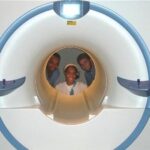Catching a brain tumor in your dog before it shows symptoms may be possible with annual MRI scans, but would a yearly MRI scan make a difference in the prognosis or survival odds? After all, the earlier that a brain tumor is detected in a dog, the more treatable it is, right?
Well, I wondered about this and consulted with Dr. Peter Gordon, DVM, Dipl. ACVIM (Neurology)
Veterinary Specialty Center of Tucson, Tucson, AZ. Before consulting with Dr. Gordon, I had initially thought that if a brain tumor is caught early, long before it starts showing signs in a dog, it would be more operable, and whatever was left could be more easily treated with drugs and radiation, versus if the brain tumor was huge and comprised of multiple branch-like extensions into the brain matter.
I even speculated that an MRI done every six months would for sure go a very long way in boosting survival odds, since how much can a new cancerous mass progress in only six months?
Dr. Gordon explains, “Certain types of brain tumors can grow faster than six months. As such, a twice yearly scan could miss one of these rapidly expanding masses.”
Dr. Gordon continues, “Brain tumors are very rarely cured and as such, even if the mass was detected earlier, it cannot be said that it would guarantee prevention of death via the brain tumor. Cure is difficult in these cases. In order to remove a tumor surgically, you must remove the tumor and everything it touches with an acceptable margin (standard rule of oncological surgery).”
“Since these tumors are in the brain, to ensure complete removal, one would have to remove the tumor and everything it touches. In other words, the brain. As this is not compatible with survival, the tumor will often return from residual tissue left behind.”
“Radiation therapy or chemotherapy can be used to help destroy / retard the growth of any remaining tissue, but even these modalities are not 100 percent effective for all tumor types. Earlier identification would make the surgery for a suitable candidate easier, and would likely result in a longer time in remission, but I don’t think we can promise that it would prevent ultimate deterioration and/or death.”
Dr. Gordon also explains that not all malignancies, because of their location, are surgically treatable. And if that isn’t bad enough, not all cancerous masses in a dog will respond to chemotherapy or radiation. He says, “In these cases, identification regardless of timing is not going to prevent them from ‘getting out of control.'”
And then there’s the cost of the yearly, and especially twice-yearly, MRI. An MRI for a dog can cost between $1,500 and $3,000. However, an MRI certainly won’t hurt a dog (no radiation). “But, the general anesthesia required to complete an MRI on a canine patient does carry some risk, says Dr. Gordon.
For all you know, the routine MRI will catch a more inherently treatable brain tumor, and the early detection will get you substantially more time with your dog than if the mass were discovered on a more conventional time line; that is, when the dog starts exhibiting signs such as a seizure, constant pacing or circling, vomiting, and personality changes.



